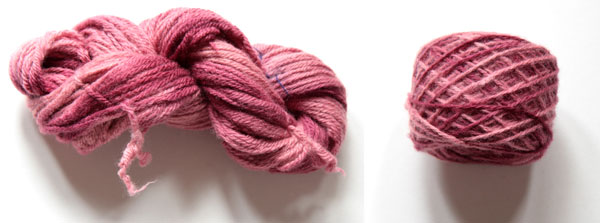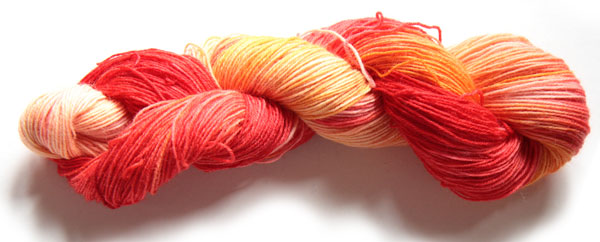Colourful Saturday
1 comment
From left to right: Berry Blue Kool Aid, Brazilwood extract, Lac extract, Teal extract x2, multi Kool Aid
Yesterday, I had a couple of friends round for a day of dyeing experiments. I have spent the last few weeks procuring and preparing. It was very hard to resist dipping into the supplies until the big day.
We had a range of dyes at our disposal; natural dye extracts, Procion acid dyes, Kool Aid and onion skins. Yarn-wise, we had undyed organic merino aran and superwash BFL sock yarn, half of it pre-mordanted with alum for use with natural dyes.
Amazingly, everything we tried turned out really well and I will write up proper instructions for Kool Aid dyeing, acid dyes, mordanting and natural dyes as features soon.

Dyeing supplies
The onion skin dye took very well on alum mordanted BFL (no pics sadly). Books suggested we’d get bright yellow but we got a rich tan.
I prepared the onion skin bath in advance as this took some time. I had been saving red and yellow onion skins for a month or so and had a larger freezer bag full (we do get through A LOT of onions), weighing approx 60 g. I had read that we’d need 100 g per 100 g of yarn to get a reasonable colour, but we got a very good depth of colour with what we had. To make the dye bath, I boiled the onion skins in filtered water for about 3 hours, then sieved the liquid, squeezing the juice out of the skins. I was told this make the house stink, so I was presently surprised when it did not.
We simmered the yarn in the onion liquid for about 2 hours, though it only took about half an hour for all the dye to absorb. The colour did not bleed during rinsing. Although it would take a long time to collect enough onion skins to dye a big batch, they are reliable and effectively free.

Lac extract 1/2 tsp on 100 g organic merino, alum mordant
Powdered extracts are a great alternative to natural dyes in their original form. They require no prep and tend to be more uniform and predictable. We tried lac (pink – made from the crushed shells of beetles), brazilwood (pink / burgundy – a tree bark, good vegetable alternative to lac and cochineal) and teal (blue-green – a mixture of plant extracts). We used about 1/2 tsp extract per 100 g of yarn. The extracts simply dissolve in water like synthetic dye powders. We simmered the yarn in the dye baths for 1 – 1.5 hours.
Unlike synthetic pigments, the strength of colour varied a lot for the different extracts. Lac and teal were pale at the quantities we used, while brazilwood was darker and richer. It would take some experimentation to obtain a particular shade, but we were very happy with what we got. The lac bled slightly during rinsing but all seemed fast.

Brazilwood extract 1/2 tsb on 100 g organic merino aran, alum mordant

Teal extract 1/2 tsp per 100 g, alum mordant. Left: superwash BFL sock, right: organic mernio aran

Kool Aid rainbow: 1 x Pineapple, 1 x Strawberry, 1 x Berry Blue, 1 x Grape
We also had some fun with Kool Aid. A large sauté pan turns out to be the perfect piece of equipment for making multi-coloured skeins without painting. We spread the yarn out in the pan, added enough water to cover and sprinkled Kool Aid straight in, with different colours in different areas, then simmered the bath for 30 minutes. Kool Aid dye takes so quickly, especially on superwash, that the colours don’t really bleed unless you want them to. Hanne’s rainbow skein was possibly the most exciting thing I have ever seen (sadly no pics of the finished item). I made a red and yellow version using the same technique.

Kool Aid: 1 x Pineapple, 1 x Orange, 2 x strawberry on superwash BFL sock
So, big success! Lots of fantastic yarn for everyone, and my kitchen didn’t end up multicoloured. Although, I’ve yet to work out how to wash, mordant, dye and rinse that lovely organic merino without it felting somewhere along the way!
Oh my gosh, so exciting! I would absolutely love a write-up of how to use Kool Aid. I bought a little starter set to play around with but haven’t plucked up my courage yet. Any handy hints would be extremely welcome!
The Brazilwood extract sounds very interesting, must keep that in mind.